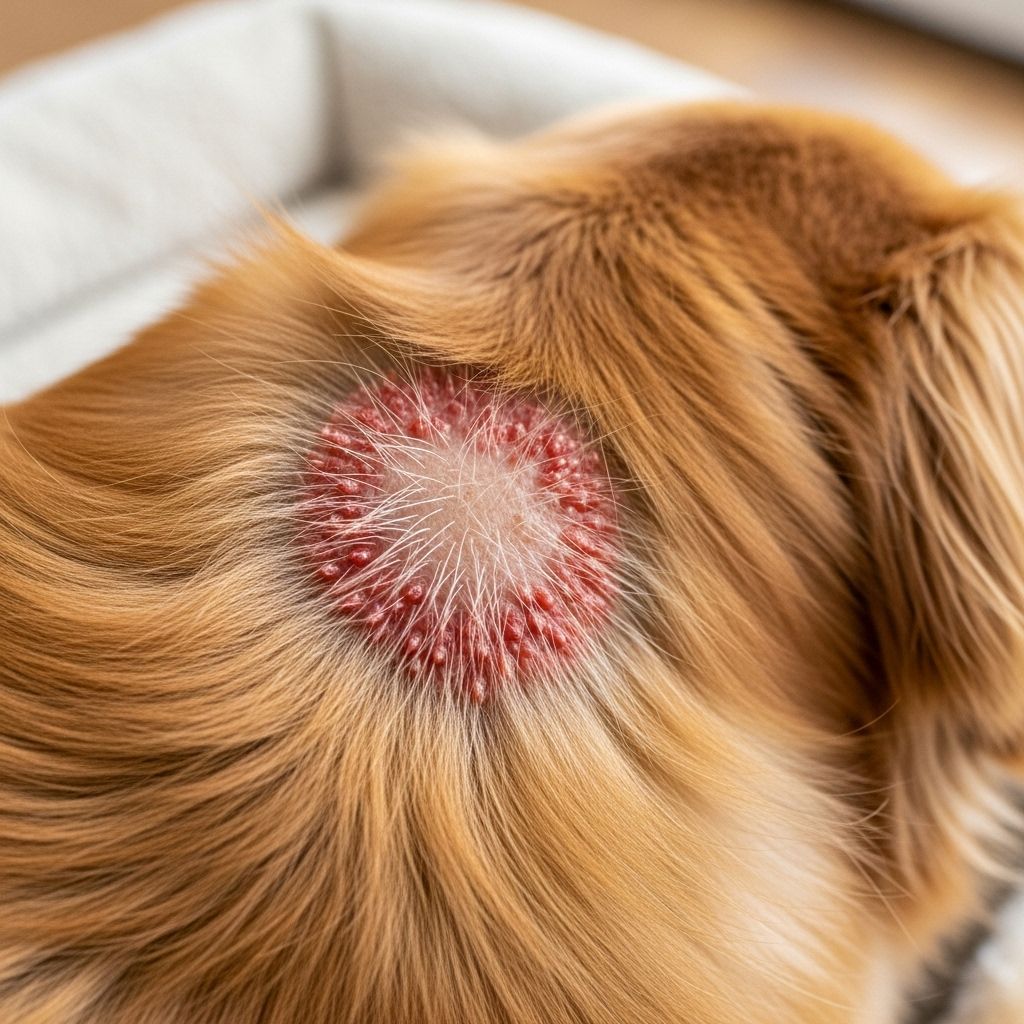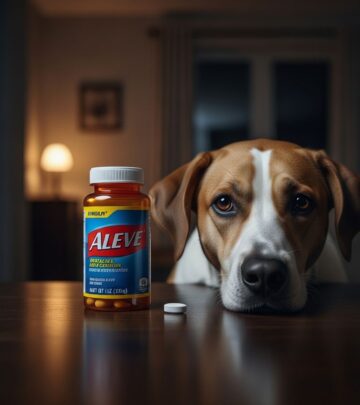Ringworm In Dogs: Signs, Symptoms, And 6-Step Treatment Guide
Comprehensive guide to identifying, treating, and preventing ringworm in dogs while protecting people and pets.

Image: HearthJunction Design Team
Ringworm in Dogs: Signs, Symptoms, and Treatment
Ringworm is a frequent, highly contagious fungal infection that affects dogs’ skin, hair, and sometimes nails. Despite the name, ringworm is caused not by a worm but by a dermatophyte fungus, most commonly Microsporum canis. Understanding how to recognize, treat, and prevent ringworm is crucial for pet owners, as the infection is not just uncomfortable for your dog; it can also spread to humans and other animals.
What is Ringworm?
Ringworm is a dermatophytosis—a fungal infection of the skin, hair, or claws. The misleading name comes from the classic ring-shaped skin lesions that sometimes develop. The fungus invades the keratinized tissues, leading to a variety of symptoms and health risks in dogs and people alike.
- Common Species: The primary culprit in dogs is Microsporum canis, but other fungi like Microsporum gypseum and Trichophyton mentagrophytes can also cause infection.
- Contagion: Ringworm spreads through direct contact with an infected animal or contaminated objects such as bedding, grooming tools, and furniture.
- Zoonotic Risk: Humans can catch ringworm from dogs, making prompt diagnosis and treatment essential for household health.
Symptoms of Ringworm in Dogs
The clinical signs of ringworm infection can vary. Some dogs display clear, classic symptoms, while others may have more subtle indications of infection.
- Circular areas of hair loss: Typically, these spots have a red, inflamed border and are most common on the head, ears, paws, and legs.
- Dry, brittle hair: Hair in affected areas often breaks easily, leading to patchy baldness.
- Scabby, inflamed skin: The skin in the hairless patches may be crusty, scaly, or even pus-filled in severe cases.
- Rough, brittle claws: When claws are involved, they may become misshapen or rough to the touch.
Some dogs may be asymptomatic carriers, spreading the fungus to others without ever showing clear signs themselves.
How Do Dogs Get Ringworm?
Dogs most often contract ringworm through:
- Direct contact with infected animals: Including other dogs, cats, or even wildlife.
- Contact with contaminated objects: Bedding, brushes, toys, and furniture can all harbor infectious fungal spores.
- Environmental exposure: Fungal spores can survive for up to 18 months in the environment, especially in warm, humid conditions.
Puppies, elderly dogs, and those with weakened immune systems are at greater risk for infection. Environments with many animals, like shelters or kennels, see more frequent outbreaks due to the ease of spread.
Can Humans Get Ringworm from Dogs?
Yes, ringworm is a zoonotic disease, meaning it can infect both animals and humans.
- Who is at risk? Young children, the elderly, and immunocompromised individuals are especially susceptible.
- Human symptoms: In people, ringworm presents as circular, itchy, red rashes—often called “athlete’s foot” when on the feet or “jock itch” in the groin.
- If you observe such rashes after contact with an infected dog, consult a physician promptly for diagnosis and treatment.
This zoonotic potential underscores the importance of swift and thorough treatment—not just for your dog’s comfort, but to safeguard your entire household.
Diagnosing Ringworm in Dogs
Veterinarians diagnose ringworm based on a combination of physical examination and specialized tests:
- Wood’s lamp examination: About half of Microsporum canis infections cause infected hair to fluoresce apple-green under ultraviolet light. However, this is not foolproof—other dermatophytes do not glow, and not all cases of M. canis do either.
- Fungal culture: Hair or skin scrapings are placed on a special medium to see if the fungus grows. This is the gold standard for diagnosis but can take several weeks for results.
- Microscopic examination: Infected hairs can sometimes be identified under a microscope by their characteristic spores.
In some cases, especially if the diagnosis is unclear, molecular testing or biopsies may be necessary.
Treatment of Ringworm in Dogs
Treatment plans must be tailored to the severity of infection, number of pets at home, and whether there are high-risk people in the household. Most protocols have multiple components:
- Topical therapy: Antifungal creams, ointments, or medicated shampoos may be applied directly to lesions. Veterinarians often recommend clipping hair around affected areas for deeper penetration. Lime-sulfur dips and miconazole shampoos are common topical treatments.
- Oral medications: For widespread or persistent infections, oral antifungals such as griseofulvin, itraconazole, or terbinafine may be necessary. These drugs require several weeks of treatment and close veterinary supervision due to potential side effects.
- Environmental decontamination: Because fungal spores are resilient, rigorous cleaning is essential. Wash bedding, toys, and other washable items with hot water and a bleach solution if possible. Vacuum carpets and furniture frequently, then dispose of the vacuum bag or clean the canister to prevent reinfection.
Your veterinarian will recommend the most effective combination for your situation. In multi-pet households, all animals should be screened and possibly treated at the same time to prevent recurrence.
Step-by-Step Guide to Treating Ringworm in Dogs
- Isolate the infected dog: Prevent spread to other animals and people by confining your dog to easy-to-clean areas.
- Begin prescribed treatment: Apply topical medications and/or administer oral antifungals exactly as directed by your veterinarian.
- Clean the environment daily: Wash bedding and toys, vacuum floors and furniture, and wipe down hard surfaces.
- Disinfect grooming tools: Soak combs and brushes in a diluted bleach solution after each use.
- Monitor for new lesions: Check your dog (and other pets) daily for any new hairless patches or skin changes.
- Follow up with your vet: Attend all recommended rechecks. Your vet may repeat cultures to confirm the infection is gone before discontinuing treatment.
Preventing Ringworm in Your Home
- Avoid contact: Keep your pets away from animals with visible skin lesions or those known to have ringworm.
- Hygiene: Wash hands thoroughly after handling pets and clean their living areas regularly.
- Regular vet exams: Seek veterinary attention if you notice hair loss, scabs, or unusual skin changes in your dog.
- Prompt cleaning: Address spills, waste, and debris in your pet’s living areas quickly to limit the spread of spores.
Frequently Asked Questions (FAQs)
Q: Is ringworm dangerous to dogs?
A: While ringworm is rarely life-threatening, it can cause significant discomfort, fur loss, and lead to secondary infections. If left untreated, it can easily spread to other pets and people.
Q: How long does it take to treat ringworm in dogs?
A: Treatment often lasts several weeks, sometimes extending beyond a month, depending on the infection’s severity and how quickly the fungus is eradicated from the environment and the pet.
Q: Can I use over-the-counter antifungals on my dog?
A: Human antifungal creams are not always safe or effective for dogs. Always consult your veterinarian before using any medication.
Q: Will my dog need to be quarantined?
A: Yes, isolating your pet during treatment minimizes the spread of infection to other pets and family members. Follow your vet’s advice on handling and cleaning protocols.
Q: Are some dogs more at risk for ringworm?
A: Puppies, senior dogs, and those with weakened immune systems are at higher risk. Dogs in crowded environments, like kennels and shelters, are also more susceptible.
When to See the Vet
Contact your veterinarian if you notice any signs of ringworm such as circular hair loss, scabby lesions, or inflamed skin. Early diagnosis allows for faster, more effective treatment and reduces the risk of spread.
Conclusion
Ringworm in dogs, while not typically severe, poses a significant risk due to its contagious nature and zoonotic potential. Recognizing the signs early, following your veterinarian’s treatment plan, and rigorously cleaning your home are critical steps to protecting your pet and family. With patience and proper care, most dogs recover fully and can return to happy, healthy lives.
References
- https://www.akc.org/expert-advice/health/ringworm-in-dogs/
- https://www.wisconsindesignerdoodles.com/stokeshire-doodle-puppy-blog/how-to-treat-ringworm-in-dogs-a-step-by-step-guide
- https://vcahospitals.com/know-your-pet/ringworm-in-dogs
- https://www.nasdaq.com/articles/ringworm-in-dogs:-complete-guide
- https://americanpetsalive.org/uploads/resources/Ringworm-Diagnosis-and-Treatment-Protocols.pdf
Read full bio of Srija Burman












